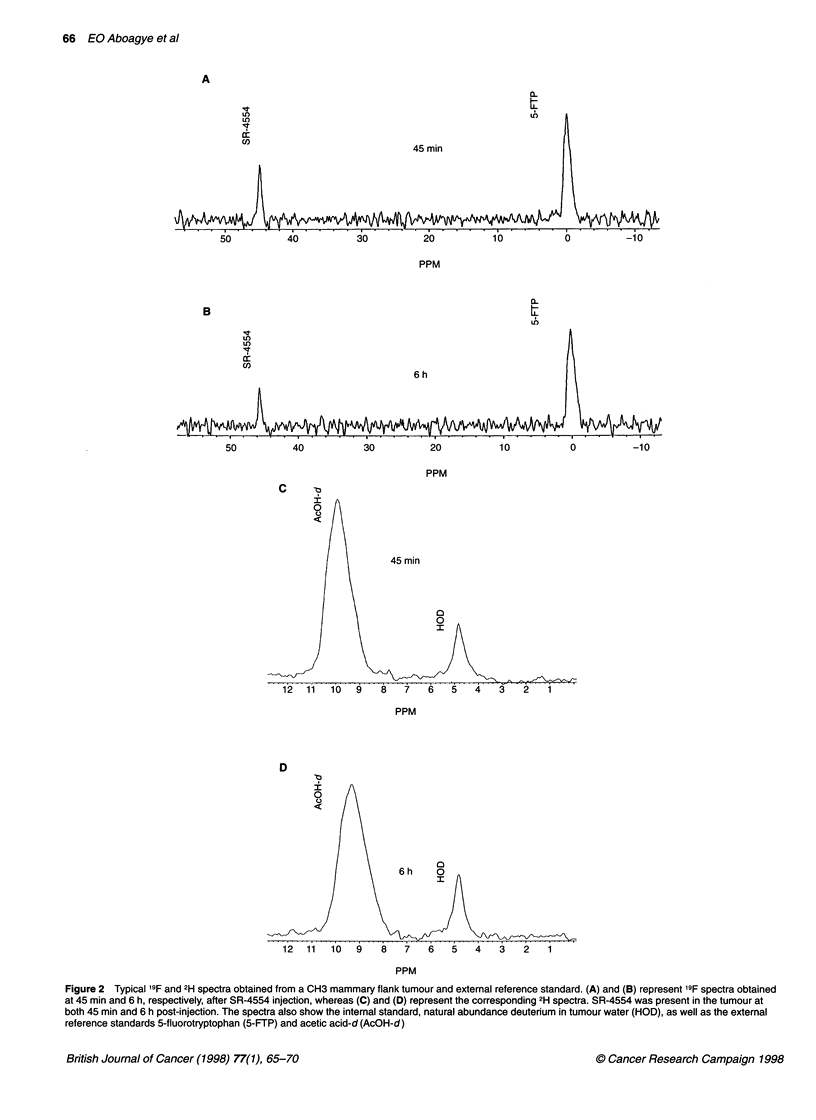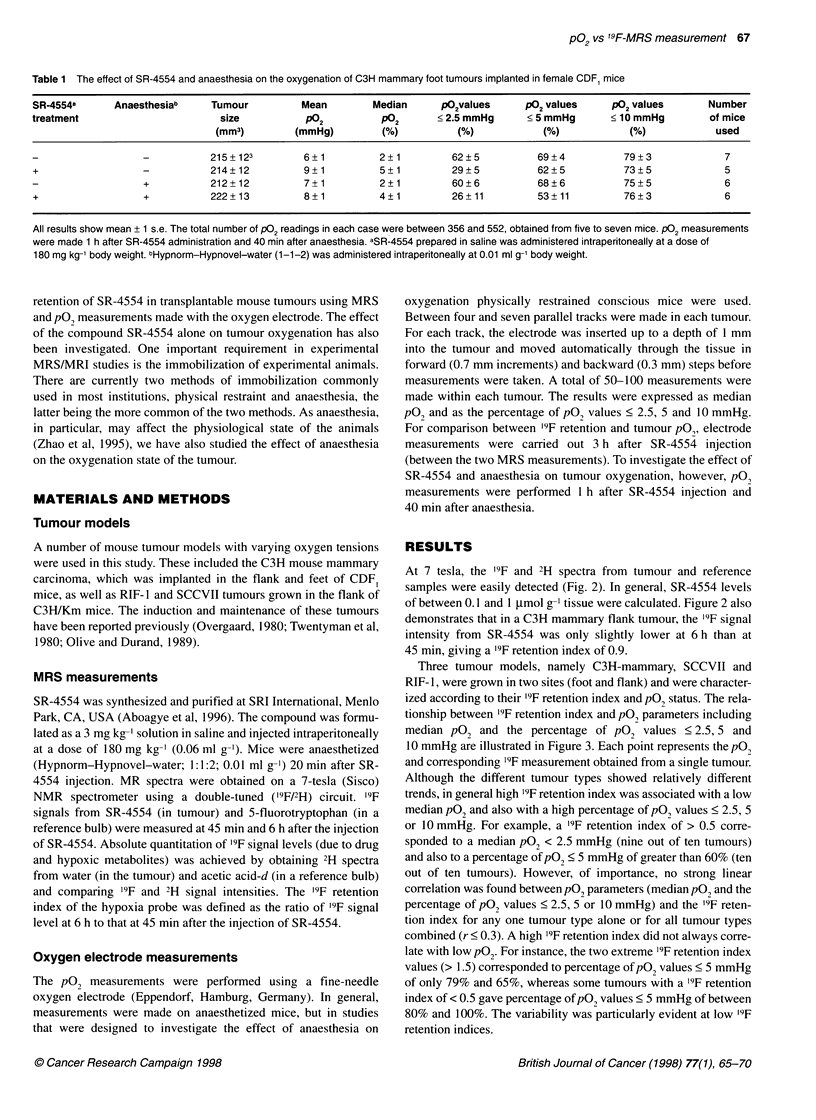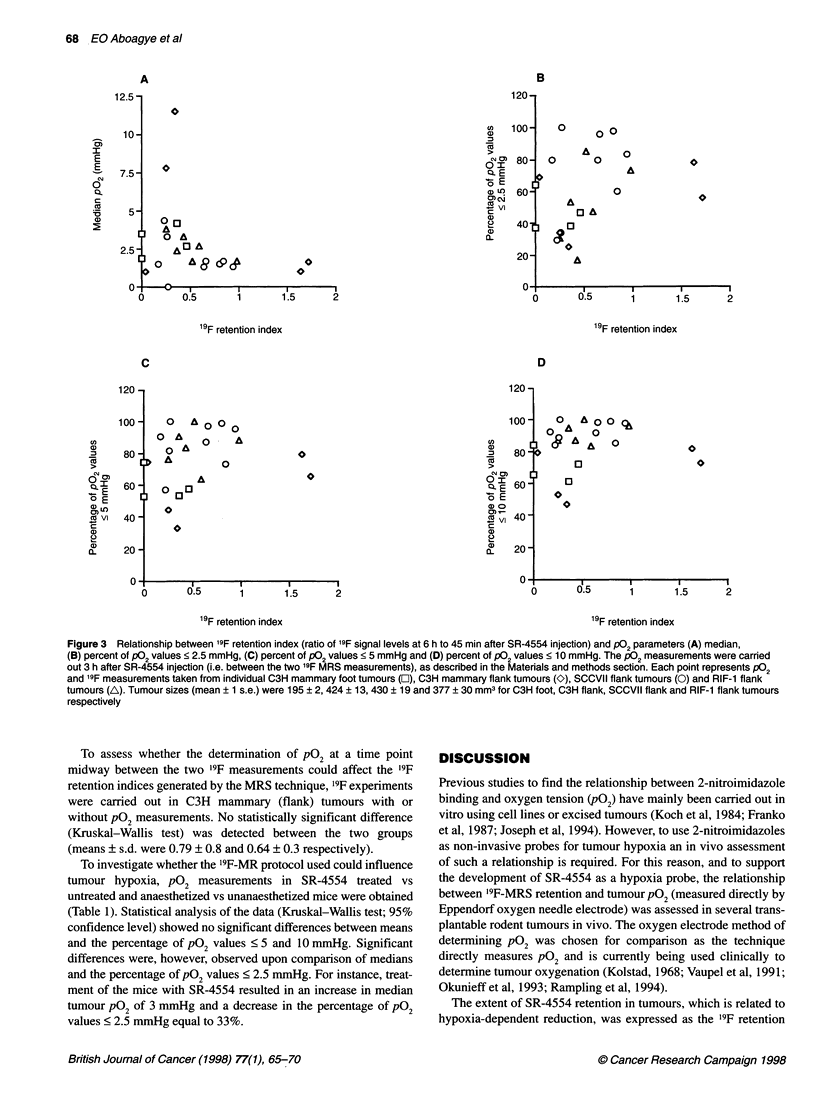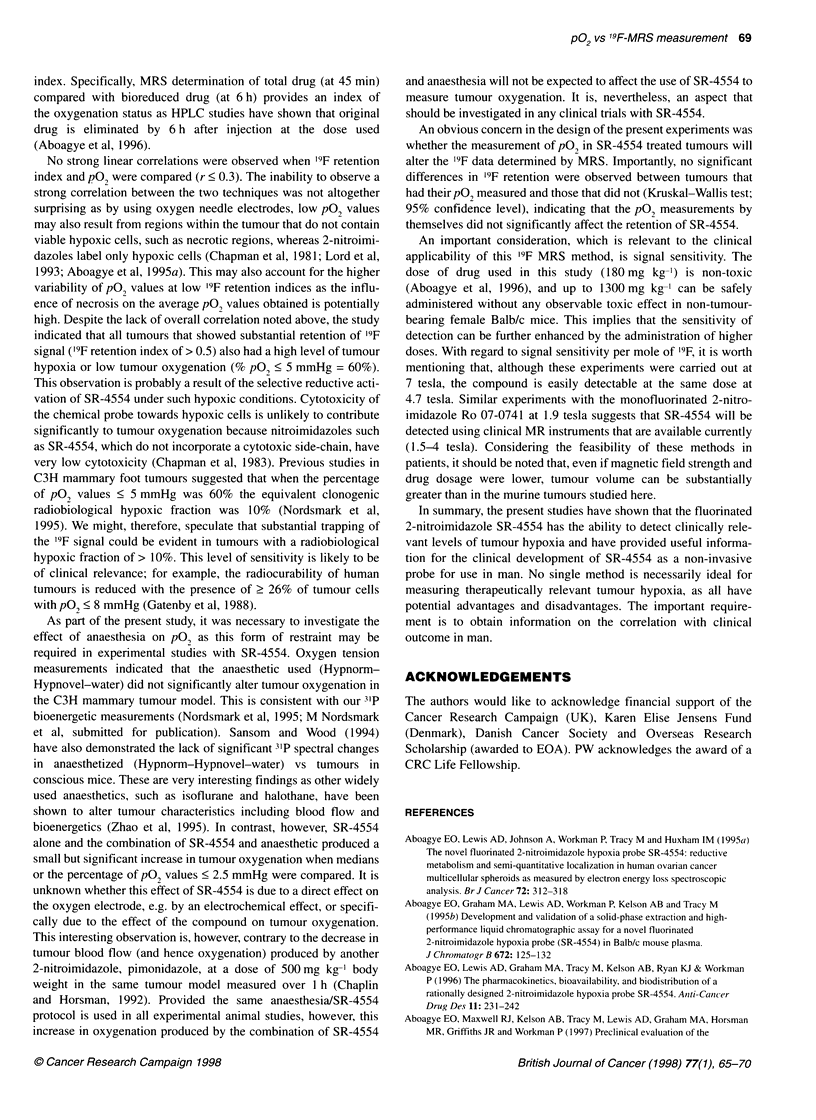Abstract
The relationship between two methods of assessing tumour oxygenation in vivo, namely oxygen electrode measurement and magnetic resonance spectroscopy (MRS) of the fluorinated 2-nitroimidazole SR-4554, was investigated. Using three tumour models (two sites), no linear correlation was observed between 19F retention index and pO2 parameters (r < or = 0.3). Substantial retention of SR-4554 (19F retention index > 0.5) was, however, associated with low tumour pO2 (% pO2 < or = 5 mmHg = 60%). Depending on the pO2 parameters used, SR-4554 administration was shown to produce either a significant or a non-significant increase in tumour oxygenation. We conclude that measurement of SR-4554-related compound(s) by 19F-MRS has the potential to detect clinically relevant levels of tumour hypoxia.
Full text
PDF





Selected References
These references are in PubMed. This may not be the complete list of references from this article.
- Aboagye E. O., Lewis A. D., Graham M. A., Tracy M., Kelson A. B., Ryan K. J., Workman P. The pharmacokinetics, bioavailability and biodistribution in mice of a rationally designed 2-nitroimidazole hypoxia probe SR-4554. Anticancer Drug Des. 1996 Apr;11(3):231–242. [PubMed] [Google Scholar]
- Aboagye E. O., Lewis A. D., Johnson A., Workman P., Tracy M., Huxham I. M. The novel fluorinated 2-nitroimidazole hypoxia probe SR-4554: reductive metabolism and semiquantitative localisation in human ovarian cancer multicellular spheroids as measured by electron energy loss spectroscopic analysis. Br J Cancer. 1995 Aug;72(2):312–318. doi: 10.1038/bjc.1995.330. [DOI] [PMC free article] [PubMed] [Google Scholar]
- Brizel D. M., Rosner G. L., Prosnitz L. R., Dewhirst M. W. Patterns and variability of tumor oxygenation in human soft tissue sarcomas, cervical carcinomas, and lymph node metastases. Int J Radiat Oncol Biol Phys. 1995 Jul 15;32(4):1121–1125. doi: 10.1016/0360-3016(95)00106-9. [DOI] [PubMed] [Google Scholar]
- Chaplin D. J., Horsman M. R. Tumor blood flow changes induced by chemical modifiers of radiation response. Int J Radiat Oncol Biol Phys. 1992;22(3):459–462. doi: 10.1016/0360-3016(92)90853-a. [DOI] [PubMed] [Google Scholar]
- Chapman J. D., Baer K., Lee J. Characteristics of the metabolism-induced binding of misonidazole to hypoxic mammalian cells. Cancer Res. 1983 Apr;43(4):1523–1528. [PubMed] [Google Scholar]
- Chapman J. D., Franko A. J., Sharplin J. A marker for hypoxic cells in tumours with potential clinical applicability. Br J Cancer. 1981 Apr;43(4):546–550. doi: 10.1038/bjc.1981.79. [DOI] [PMC free article] [PubMed] [Google Scholar]
- Chapman J. D. The detection and measurement of hypoxic cells in solid tumors. Cancer. 1984 Dec 1;54(11):2441–2449. doi: 10.1002/1097-0142(19841201)54:11<2441::aid-cncr2820541122>3.0.co;2-s. [DOI] [PubMed] [Google Scholar]
- Franko A. J., Koch C. J., Garrecht B. M., Sharplin J., Hughes D. Oxygen dependence of binding of misonidazole to rodent and human tumors in vitro. Cancer Res. 1987 Oct 15;47(20):5367–5376. [PubMed] [Google Scholar]
- Gatenby R. A., Kessler H. B., Rosenblum J. S., Coia L. R., Moldofsky P. J., Hartz W. H., Broder G. J. Oxygen distribution in squamous cell carcinoma metastases and its relationship to outcome of radiation therapy. Int J Radiat Oncol Biol Phys. 1988 May;14(5):831–838. doi: 10.1016/0360-3016(88)90002-8. [DOI] [PubMed] [Google Scholar]
- Horsman M. R., Khalil A. A., Siemann D. W., Grau C., Hill S. A., Lynch E. M., Chaplin D. J., Overgaard J. Relationship between radiobiological hypoxia in tumors and electrode measurements of tumor oxygenation. Int J Radiat Oncol Biol Phys. 1994 Jun 15;29(3):439–442. doi: 10.1016/0360-3016(94)90434-0. [DOI] [PubMed] [Google Scholar]
- Jin G. Y., Li S. J., Moulder J. E., Raleigh J. A. Dynamic measurements of hexafluoromisonidazole (CCI-103F) retention in mouse tumours by 1H/19F magnetic resonance spectroscopy. Int J Radiat Biol. 1990 Dec;58(6):1025–1034. doi: 10.1080/09553009014552331. [DOI] [PubMed] [Google Scholar]
- Joseph P., Jaiswal A. K., Stobbe C. C., Chapman J. D. The role of specific reductases in the intracellular activation and binding of 2-nitroimidazoles. Int J Radiat Oncol Biol Phys. 1994 May 15;29(2):351–355. doi: 10.1016/0360-3016(94)90288-7. [DOI] [PubMed] [Google Scholar]
- Kavanagh M. C., Sun A., Hu Q., Hill R. P. Comparing techniques of measuring tumor hypoxia in different murine tumors: Eppendorf pO2 Histograph, [3H]misonidazole binding and paired survival assay. Radiat Res. 1996 Apr;145(4):491–500. [PubMed] [Google Scholar]
- Koch C. J., Stobbe C. C., Baer K. A. Metabolism induced binding of 14C-misonidazole to hypoxic cells: kinetic dependence on oxygen concentration and misonidazole concentration. Int J Radiat Oncol Biol Phys. 1984 Aug;10(8):1327–1331. doi: 10.1016/0360-3016(84)90342-0. [DOI] [PubMed] [Google Scholar]
- Kolstad P. Intercapillary distance, oxygen tension and local recurrence in cervix cancer. Scand J Clin Lab Invest Suppl. 1968;106:145–157. [PubMed] [Google Scholar]
- Kwock L., Gill M., McMurry H. L., Beckman W., Raleigh J. A., Joseph A. P. Evaluation of a fluorinated 2-nitroimidazole binding to hypoxic cells in tumor-bearing rats by 19F magnetic resonance spectroscopy and immunohistochemistry. Radiat Res. 1992 Jan;129(1):71–78. [PubMed] [Google Scholar]
- Lord E. M., Harwell L., Koch C. J. Detection of hypoxic cells by monoclonal antibody recognizing 2-nitroimidazole adducts. Cancer Res. 1993 Dec 1;53(23):5721–5726. [PubMed] [Google Scholar]
- Maxwell R. J., Workman P., Griffiths J. R. Demonstration of tumor-selective retention of fluorinated nitroimidazole probes by 19F magnetic resonance spectroscopy in vivo. Int J Radiat Oncol Biol Phys. 1989 Apr;16(4):925–929. doi: 10.1016/0360-3016(89)90888-2. [DOI] [PubMed] [Google Scholar]
- Mueller-Klieser W., Schlenger K. H., Walenta S., Gross M., Karbach U., Hoeckel M., Vaupel P. Pathophysiological approaches to identifying tumor hypoxia in patients. Radiother Oncol. 1991;20 (Suppl 1):21–28. doi: 10.1016/0167-8140(91)90182-g. [DOI] [PubMed] [Google Scholar]
- Nordsmark M., Grau C., Horsman M. R., Jörgensen H. S., Overgaard J. Relationship between tumour oxygenation, bioenergetic status and radiobiological hypoxia in an experimental model. Acta Oncol. 1995;34(3):329–334. doi: 10.3109/02841869509093984. [DOI] [PubMed] [Google Scholar]
- Okunieff P., Hoeckel M., Dunphy E. P., Schlenger K., Knoop C., Vaupel P. Oxygen tension distributions are sufficient to explain the local response of human breast tumors treated with radiation alone. Int J Radiat Oncol Biol Phys. 1993 Jul 15;26(4):631–636. doi: 10.1016/0360-3016(93)90280-9. [DOI] [PubMed] [Google Scholar]
- Olive P. L., Durand R. E. Misonidazole binding in SCCVII tumors in relation to the tumor blood supply. Int J Radiat Oncol Biol Phys. 1989 Mar;16(3):755–761. doi: 10.1016/0360-3016(89)90495-1. [DOI] [PubMed] [Google Scholar]
- Overgaard J. Effect of misonidazole and hyperthermia on the radiosensitivity of a C3H mouse mammary carcinoma and its surrounding normal tissue. Br J Cancer. 1980 Jan;41(1):10–21. doi: 10.1038/bjc.1980.2. [DOI] [PMC free article] [PubMed] [Google Scholar]
- Raleigh J. A., Franko A. J., Kelly D. A., Trimble L. A., Allen P. S. Development of an in vivo 19F magnetic resonance method for measuring oxygen deficiency in tumors. Magn Reson Med. 1991 Dec;22(2):451–466. doi: 10.1002/mrm.1910220253. [DOI] [PubMed] [Google Scholar]
- Rampling R., Cruickshank G., Lewis A. D., Fitzsimmons S. A., Workman P. Direct measurement of pO2 distribution and bioreductive enzymes in human malignant brain tumors. Int J Radiat Oncol Biol Phys. 1994 Jun 15;29(3):427–431. doi: 10.1016/0360-3016(94)90432-4. [DOI] [PubMed] [Google Scholar]
- Sansom J. M., Wood P. J. 31P MRS of tumour metabolism in anaesthetized vs conscious mice. NMR Biomed. 1994 Jun;7(4):167–171. doi: 10.1002/nbm.1940070403. [DOI] [PubMed] [Google Scholar]
- Twentyman P. R., Brown J. M., Gray J. W., Franko A. J., Scoles M. A., Kallman R. F. A new mouse tumor model system (RIF-1) for comparison of end-point studies. J Natl Cancer Inst. 1980 Mar;64(3):595–604. [PubMed] [Google Scholar]
- Vaupel P., Schlenger K. H., Hoeckel M., Okunieff P. Oxygenation of mammary tumors: from isotransplanted rodent tumors to primary malignancies in patients. Adv Exp Med Biol. 1992;316:361–371. doi: 10.1007/978-1-4615-3404-4_41. [DOI] [PubMed] [Google Scholar]
- Vaupel P., Schlenger K., Knoop C., Höckel M. Oxygenation of human tumors: evaluation of tissue oxygen distribution in breast cancers by computerized O2 tension measurements. Cancer Res. 1991 Jun 15;51(12):3316–3322. [PubMed] [Google Scholar]
- Zhao M., Fortan L. G., Evelhoch J. L. The effects of isoflurane and halothane on blood flow and 31P NMR spectra in murine RIF-1 tumors. Magn Reson Med. 1995 May;33(5):610–618. doi: 10.1002/mrm.1910330505. [DOI] [PubMed] [Google Scholar]


